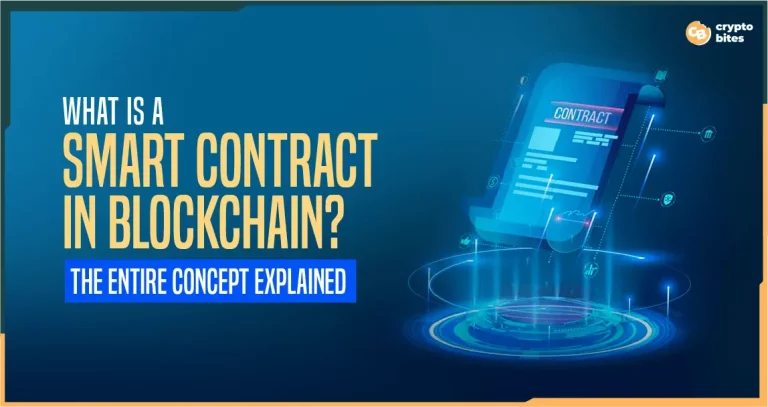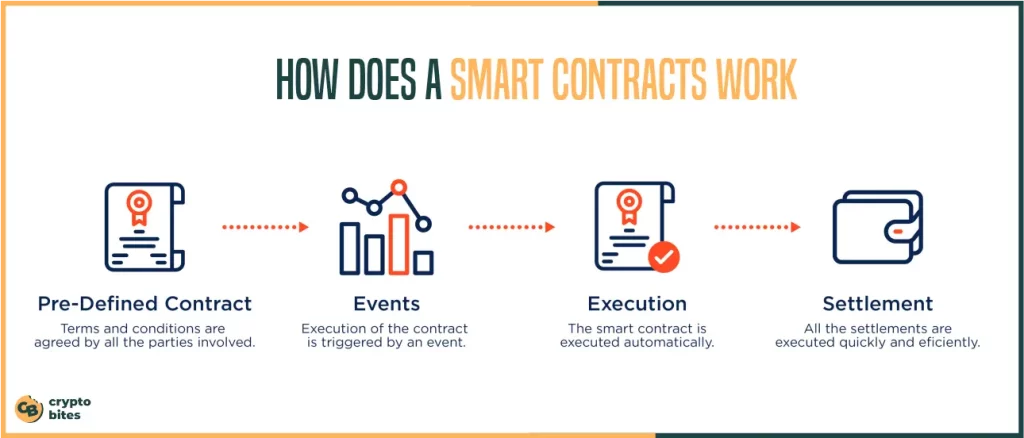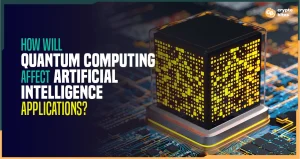
What is a Smart Contract? – Everything You Need to Know
Imagine you want to buy a house.
In the past, you needed to involve various intermediaries, such as real estate agents, lawyers, and banks, to ensure a smooth transaction. It could be a lengthy and cumbersome process.
Now, picture a smart contract as a digital notary. You and the seller agree on the terms, and these terms are encoded into the smart contract.
When you fulfill the conditions, like making the payment and meeting legal requirements, the smart contract automatically verifies and validates the transaction. It’s like having a digital notary present at all times, ensuring that everything is in order.
This eliminates the need for middlemen and streamlines the process. No need to wait for banks to process payments or lawyers to review documents. Smart contracts make transactions faster, more secure, and cost-effective, just like having a digital notary at your service 24/7.
Smart contracts, however, involve a lot more other stuff too.
And in this guide, I will explore every little thing that is related to smart contracts.
Let’s break down smart contracts in a way that’s easy to understand. In this guide, I’ll explain all the different aspects of smart contracts, covering everything you need to know.
Why a Smart Contract?
What makes smart contracts remarkable is their ability to facilitate swift and secure transactions between strangers, regardless of their geographical locations. They achieve this without the need for intermediaries or concerns about the outcome, thanks to the vigilant oversight of mathematical algorithms.
Transactions conducted through smart contracts are entirely automated. The smart contract becomes an integral part of a blockchain’s code, and when all the contract’s conditions are satisfied, the algorithm takes charge independently, ensuring a seamless and trustless exchange of value.
How Smart Contracts Work
Smart contracts are the digital maestros of agreements in the world of blockchain.
So what is a smart contract? It’s basically a strong digital deed where you can make deals enforceable through code execution on a blockchain platform, eliminating the need for intermediaries and ensuring trustless transactions.

Now, the magic happens with the “If-Then” logic. If the key arrives on schedule, smooth sailing. But if it’s fashionably late, the blockchain steps in, automatically giving you a refund. It’s like having an army of guardians ensuring fairness.
Smart contracts aren’t just for rentals; they’re the Swiss Army knives of agreements. Whether you’re into financial wizardry or insurance, they’ve got you covered. They’re basically the digital twins of old-school paper contracts. Instead of ink, they use mathematical codes, and signatures are electronic.
What Makes It All Possible?
At its core, a smart contract is a digital agreement created between parties, no different to traditional contracts. However, instead of paper and signatures, they rely on lines of code using the blockchain as a medium.
Here is a step-by-step guide that explains the process in detail:
Step 1 – Agreement and Creation
This initial stage starts with a clear agreement between parties. In this phase, the parties define and agree upon the terms and conditions of their transaction or arrangement, ensuring every detail is considered and understood.
Translating these terms into a programming language is an art in itself. It’s similar to a translator carefully converting a story from one language to another, ensuring the essence and meaning remain true to the original. This translation process is not just a simple conversion but a re-creation of the agreement in a new form that computers can understand and execute.
Creating a smart contract can be approached in different ways, depending on the skills and resources available. Some may choose to draft the contract themselves, while others might collaborate with expert developers. Think of an artist painting their own portrait versus regular people hiring an experienced painter to bring their vision to life.
Step 2 – Deployment
This phase involves broadcasting the smart contract to the blockchain, making it a permanent part of the digital ledger. Once the contract is deployed, it cannot be altered. That is why thorough accuracy and testing before this stage is important.
Once deployed, the smart contract exists independently on the blockchain. It is visible and accessible to anyone within the network.
Network nodes have a vital role during this phase because they verify the smart contract. Their verification ensures the authenticity and integrity of the contract, maintaining the security and trustworthiness of the blockchain.
Step 3 – Triggering Conditions and Contract Execution
After deployment and activation, the contract autonomously executes the encoded terms when the specified conditions are met. This autonomous operation ensures that the contract functions as intended without any further intervention.
These contracts are programmed to monitor specific events or conditions, and their actions are initiated only when these predefined criteria are met. These conditions could range from simple ones, such as reaching a specified date or completing a payment, to more complex scenarios like changes in financial derivatives or market conditions.
Step 4 – Execution and Recording
After the smart contract does its job, this activity is logged onto the blockchain. This part is really important because it means there’s a trustworthy and fixed record of all the actions the contract took.
The Benefits: A Paradigm Shift in Agreement Management
Smart contracts are destined to revolutionize how we conduct business, interact with one another, and manage our assets. Let’s delve deeper into the key benefits they offer: in the event of hardware failures or individual device losses, data remains accessible and secure, providing peace of mind and a reliable historical record.
1. Autonomy and Decentralization
Gone are the days of relying on intermediaries to oversee agreements. Smart contracts empower individuals and organizations to forge agreements directly, without the need for third-party involvement. This fosters a decentralized system where users have greater control over their transactions, eliminating unnecessary delays and promoting trustless interactions.
2. Accuracy and Explicit Recording
Traditional contracts are often plagued by ambiguity and misinterpretations. Smart contracts, however, provide a solution by explicitly recording every stipulation within the agreement in code. This meticulous record ensures that agreements are executed precisely as intended, eliminating any possibility of errors.
3. Transparency and Simplified Dispute Resolution
The transparency inherent in smart contracts significantly reduces the risk of disputes. All participants have complete visibility into the terms and conditions, eliminating hidden clauses. This transparency not only minimizes disputes but also simplifies conflict resolution by providing a clear and immutable record of the agreement.
4. Lightning-Fast Transactions and Efficiency
Unlike traditional contracts that involve manual processes and extensive documentation, smart contracts operate on software code, facilitating lightning-fast transactions. This translates to significant savings in time and resources, streamlining processes and enhancing overall efficiency.
5. Immutable Data Storage and Secure Backup
Smart contracts leverage the power of blockchain technology, ensuring that every transaction detail is permanently stored on a distributed ledger. This guarantees secure and tamper-proof storage for future reference. Evencts ensures a trustless backup system. All transactions are replicated across the blockchain network, allowing parties involved to recover their transactional history even if individual devices fail. This resilience ensures that data remains accessible and secure, even in unforeseen circumstances.
The Drawbacks: Things to Consider Beforehand
While smart contracts offer significant benefits, they are not without their limitations. Here, we delve deeper into the key disadvantages of smart contracts:
1. Hidden Loopholes and Ambiguity
Smart contracts rely on predefined conditions to execute automatically. However, this reliance can be problematic if the conditions are ambiguous or contain loopholes. Malicious actors can exploit such weaknesses to manipulate the outcome of the contract, leading to unintended consequences and breaches of agreement.
2. The Challenge of Immutability
Once deployed, smart contracts are virtually impossible to modify. While this immutability ensures security and prevents tampering, it also presents a significant challenge. If errors are discovered in the code or circumstances change, adapting the contract becomes a complex and costly endeavor.
3. Technical Errors and Vulnerability
Like any software, smart contracts are susceptible to technical errors and vulnerabilities. These flaws can have significant consequences, potentially allowing unauthorized access, freezing funds, or even leading to the complete failure of the contract.
4. Scale and Congestion
Smart contracts operate on a shared network, meaning their execution relies on the network’s capacity. When numerous contracts are deployed simultaneously, congestion can occur, leading to delays in transaction processing. In such situations, users might experience delayed execution and higher transaction fees.
5. Limited Functionality and Legal Recognition
Smart contracts excel at automating simple, predefined tasks. However, they currently struggle with handling complex scenarios that require human judgment, creativity, or adaptation to unforeseen circumstances. Additionally, the legal recognition of smart contracts remains a gray area in many jurisdictions, creating uncertainty and potentially limiting their widespread adoption.
How to Navigate the Drawbacks: A Little Smart Thinking Goes a Long Way
Smart contracts, like any powerful tool, come with their own set of challenges. But here’s are some strategies to tackle them:
1. When Immutability and Adaptability Becomes a Problem: The immutability of smart contracts, while ensuring security, can become a rigid monster when circumstances change. To tackle this issue, consider:
- Upgradable Contracts: Design contracts with upgrade mechanisms, allowing for future modifications without complete redeployment.
- DAO Integration: Utilize Decentralized Autonomous Organizations (DAOs) to govern smart contracts, enabling community-driven adaptation.
- Circuit breakers: Implement emergency shutdown mechanisms to halt execution in case of unforeseen issues.
2. Managing Vulnerabilities and Errors: Smart contracts are not immune to bugs and malicious attacks. To fend off these issues, use this tips:
- Rigorous testing: Employ thorough testing methods, including unit tests, integration tests, and penetration testing, to identify and eliminate vulnerabilities before deployment.
- Formal Verification: Utilize formal verification tools to mathematically prove the correctness of your code, minimizing the risk of errors.
- Community Audits: Seek independent audits from security experts to gain additional assurance about your contract’s robustness.
3. Bridging the Legal Chasm: The legal landscape surrounding smart contracts remains murky. To bridge this chasm, consider:
- Clearly Defined Terms: Draft contracts with clear and unambiguous language to minimize legal disputes.
- Hybrid Contracts: Combine smart contracts with traditional legal agreements to ensure enforceability in both the digital and physical realms.
- Collaborative Governance: Establish clear governance structures for resolving disputes within the smart contract ecosystem.
Remember, overcoming these challenges is an ongoing journey, not a one-time feat. By staying informed, adapting your strategies, and fostering collaboration, you can transform smart contracts from untamed beasts into powerful tools for building a more secure, efficient, and transparent future.
Building Smart Contracts without Breaking a Sweat: Your Open-Source Toolkit
Forget coding from scratch in a dimly lit basement! The world of smart contracts is opening its doors to everyone, and you don’t need a computer science degree to join the party.
Think of it like building a robot: you wouldn’t hand-craft every bolt and wire, would you? Open-source libraries are like pre-built parts, tested and ready to go. They handle the boring stuff like security protocols, data storage, and even fancy token magic, freeing you to get creative with your contract’s brain.
But the perks go beyond saving you time and brainpower:
- Speedy Development: These pre-built modules let you focus on the unique logic of your contract, escaping the boring code development marathons.
- Fort Knox Security: Open-source libraries are like your code’s bodyguards, constantly checked and audited by the community. Sleep soundly knowing your contracts are built on a rock-solid foundation.
- Free as a Bird: Say goodbye to expensive software! Open-source resources let you build cutting-edge contracts without breaking the bank. Think of it as the ultimate budget-friendly superpower.
- Community High Five: By using and contributing to open-source projects, you become part of a vibrant crew of like-minded innovators. Share ideas, collaborate on projects, and witness the collective power of brainpower!
So, where do you find these magical tools?
- OpenZeppelin Contracts: Your security Swiss army knife, with pre-built modules for token magic, governance, and more.
- ConsenSys Diligence: Your code’s knight in shining armor, hunting down vulnerabilities and keeping your contracts squeaky clean.
- Web3.js: The bridge between your smart contracts and the real world, letting them interact with websites and apps like a pro.
- Truffle Suite: Your one-stop shop for building, testing, and deploying your contracts on Ethereum. Think of it as your personal rocket launcher for your smart contract creations.
- Hardhat: Your bug-busting best friend, simulating real-world scenarios and catching errors before they cause any trouble.
However, this is just the beginning of your open-source adventure! Explore different libraries to find the perfect ones for your project.




